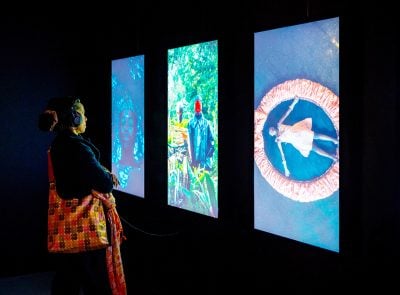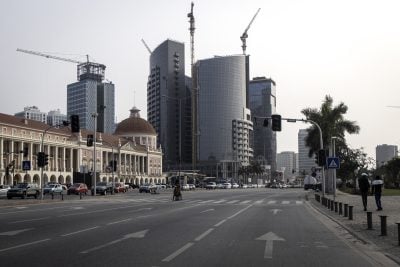According to the authors of a new book, The Fastest Billion – the story behind Africa’ s Economic Revolution, Africa’ s current sustained growth level is set to not only continue but rise over the next four decades so that, come 2050, the continent’ s GDP will equal the combined GDPs of the US and the EU at current prices. There is a possibility that Africa’ s growth could outstrip that of Asia over this time span. Some have described this scenario as over-optimistic and an exercise in wishful thinking. But the authors of the book put forward sound arguments based on analyses of trends going back centuries to support their thesis. Editor Anver Versi talked to the book’ s lead author, economist Charles Robertson, to outline the case for a defence of the theory.
The one thing most economists and historians are agreed upon is that we have not yet discovered a magic formula that allows us to explain why civilizations rise and fall when they do. The best we can do is in retrospect and assign this or that cause to the rise of this power and the decline of that power but what triggers the change that turns a humdrum nation into a mighty empire, or what series of events bring about the collapse of a mighty power continues to baffle us. There are so many ifs and buts, so many accidental turns, so much good fortune or bad fortune involved in the destiny of nations that crystal ball gazing by crunching numbers has shown up many prophets of the future to be little more than educated idiots.
Take this passage quoted by Dr Ngozi Okonjo-Iweala, Nigeria’s Minister of Finance and the former MD of the World Bank, in a foreword to The Fastest Billion: “Imagine a continent torn by multiple wars, beset by ethnic and religious warfare, malnutrition, disease and illiteracy – all of it complicated by poorly drawn borders, a still potent post-colonial stigma and the incessant meddling of outside powers.
“With a single exception, per capita income hovers at $400, primary school education reaches only a fraction of the region’s vast population and its authoritarian rulers ensure any revenues generated by the region’s rich natural resources are spent on personal, rather than national priorities. Prospects for pulling the multitudes who live at, or just above, subsistence levels seem remote, at best.”
The above passage surely describes Africa? Wrong. It describes Developing Asia in the mid 1970s, “an area of the world,” writes Okonjo-Iweala, “that had endured 200 years of decline, imperial domination and economic stagnation before beginning on the path that would transform it into the most economically vibrant zone on earth.”
So much for ‘ expert’ prediction! While the description of Developing Asia given above was accurate, the conclusion that therefore it was doomed to failure has been shown to be so much hogwash. The error was to omit any reference to the human spirit and to assume that the people would continue to live in the misery that history had dumped them into. In fact, any sensible reading of history would show that the world’ s great empires more often than not rose out of the ashes of defeat and destruction. If there is a pattern to discern, it is that those people who are most able to adapt and adopt to their times that emerge stronger and richer while those that become rigid and inflexible are fated to wither and decline.
History also shows that the need to adapt and adopt is strongest among people who face the most challenging environments and that necessity is, indeed, the mother of invention. It was true of war-torn, famine-riddled Europe in the Middle Ages and it has been true for the Asia described above. But when the turning point arrives, by whatever mysterious routes it is reached, the ascent is often rapid and spectacular.
“In the 1960s,” author Robertson told me, “all the indicators pointed to Burma (now Myanmar) as the success story while Singapore, Indonesia and Malaysia were riven by deadly ethnic violence and civil strife. Today, Singapore is 59 times richer than Myanmar and perhaps the most successful country in the world.”
Okonjo-Iweala writes: “Just as SSA has suffered through its despots and destitution, so the seedlings of transformation have pushed through the African soil. As an increasing number of economists, investors and financial policy makers have realised, SSA has emerged from its own malaise, into a dawn that promises growth to rival, if not surpass, that recorded by Asia’s Tigers over the past two decades.”
Harsh lessons
At the heart of the argument presented by the book is the observation that all societies move through various stages of development to arrive at what we now consider advanced stages. The theory is that Africa has now arrived at the same level of economic, social and political development as China, Korea and India 20-30 years ago and that given the geo-economic structure of the world, is poised to grow along the same type of trajectory as the Asian Tigers but perhaps at a faster pace, due to its advantages in possessing vast natural resources, huge tracts of cultivable land and a population structure in which productive youth will outnumber the elderly or the very young.
Robertson describes the four phases of the global economic transformation that began 200 years ago. These four phases saw countries move from agrarian to industrial states, from tyranny to pluralistic middle-class societies and increasingly into economies driven by the information age.
“These stages of growth have become the benchmarks by which we recognise a nation’s economic progress and its population’s steady journey from subsistence towards unprecedented prosperity and political pluralism now enjoyed by the world’s most advanced countries,” writes Robertson. “The process will not be complete by 2050, but Africa is set to be the final beneficiary of this revolution.”
What is more, says Robertson, the most remarkable progress will occur in the next two generations. “We expect the billion Africans who in the past decade have already experienced the fastest growth the continent has ever seen to become the fastest two billion, and Africa’ s GDP to increase from $2 trillion today to $29 trillion in today’ s money by 2050.” By that date, the argument goes, Africa will produce more GDP than the US and Eurozone combined do today.
But how can we know this is not another false dawn, I wanted to know. After all, Africa has experienced periods of rapid growth in the past, in the 1960s and ’70s before falling back into stagnation and worse. How can we know that this time things will be different?
Robertson’s response is that at independence, African nations, most of which were artificial constructs held together only by colonial administrative networks, were innocents abroad and not at all prepared for the sophisticated, cut-throat world into which they were suddenly plunged. The colonial structures were replaced by neo-colonial ones which sought, above all, to maintain the status quo of Africa as the source of cheap raw materials for the North’s industrial engines. The struggle for spheres of political and ideological influence during the Cold War pushed African national interests out of sight and led to the championing of dictators such as Mobutu Sese Seko as open agents for Western interests.
Many of Africa’s civil wars at this time were over valuable mineral resources and were supported, financed and armed by outside forces. Apartheid South Africa, acting as a Western outpost in Africa, caused considerable destabilisation in Southern Africa through murderous wars and devastated national economies at all levels through the use of land mines, many of which remain hidden in place to this day.
Even the best African leaders were inexperienced and easily duped by sharp practices from the developed world. IMF and World Bank policies, which were primarily designed to extract debt-service revenues through exports, damaged agriculture almost beyond repair and conditionalities that forced governments to cut spending on education and health. Growth figures from this era mask the fact that a good deal of it was debt. Grandiose white elephant projects ate up precious foreign revenues and income from resources were looted by local elites in conjunction with their foreign collaborators. Trillions of dollars were siphoned out of Africa.
These were harsh lessons but Africans learnt them – some more quickly than others. Yvonne Mhango, an economist with Renaissance Capital, teams up with Robertson to describe the change. “More wealth has been created in Africa in the past 10 years than at any point in the continent’s history. It is a transformation that is both bottom up – new businesses and even whole sectors have sprung up and engulfed the continent – and top down.
“Governments have got policy spectacularly right and created the low-debt, low-inflation, much-improved macro conditions that have enabled growth to take off. Africa’s private sector is thriving, supported by better governance. The consequences,” they write, “have been a quintupling of exports, record inflows of foreign direct investment and a doubling of per capita GDP.”
Africa’s public debt, once regarded as a huge rock crushing a starving continent, is now among the lowest of any continent. Thanks to debt forgiveness by the IMF and the World Bank, many African nations today enjoy improved currency stability, low public debt/GDP ratios and low budget deficits. Governments have been able to increase the maturity of their lengths of their domestic debts to 10 years, and in the case of Kenya, to even 30 years.
The contrast to the West, the book says, is stark. “If developed market finance ministers were offered three wishes today, many would ask for Africa’s public debt ratio, Africa’s budget balance and Africa’s growth.” The book points out that if Germany, Japan and the US had applied to join the Eurozone in recent times, they would have been rejected as they would have failed to meet the prudent ratios enshrined in the Maastricht criteria. On the other hand, the vast majority of Africa’ s top performing nations would have met the Maastricht public finance criteria with ease.
Sustaining growth
While Africa has got its macro economic management right, the heady heights envisioned for the continent will depend primarily on whether or not Africa can sustain its growth levels. This in turn will depend on several factors – good governance, greater democratisation, political stability, continuing global demand for commodities, greater diversification into manufacturing and services, FDI, energy generation, deeper provision of banking and financial services, support for SMEs, better quality of education, technology and skills transfer, reduction of corruption and an accelerated creating and improvement of infrastructure. The book deals with each one of these factors and comes to the conclusion that by and large, Africa is on track to deliver on all fronts. However, the authors are quick to acknowledge that not all African countries will develop at the same rate or to the same extent. Countries under authoritarian or military rule, those still mired in conflicts or those whose economies are still severely underdeveloped are likely to either stagnate or fall behind. The general trend however, is positive.
For example, according to Freedom House, the number of democracies in Africa has risen from only three in 1990 to 19 in 2012, of which nine are completely free democracies and Africa’s share of the number of people killed in violent conflict, once among the highest, has been dropping steadily. Today, only the DRC, Somalia and Sudan are among the top 10 most deadly countries in the world and only five of SSA’s 48 countries come in the top 30. This includes South Africa and Uganda, where the causes of death are less to do with political violence but due to homicides.
On the crucial question of growth rates, the book says Africa is today at the same stage as India was after its 1991 reforms and developing Asia was in the 1980s.
Africa’s mean growth rate of 5.6% in the 2000s is more than double its rate of 2.2% in the 1990s and is higher than the global average. Given the similarities between the growth curves of India after 1990 and Africa today, “to maintain an average SSA growth rate equal to what India achieved on its growth trajectory, countries with per capita GDP below $10,000 should grow by 7.3% this decade, 8.6% in the 2020s, 10.5% in the 2030s and a remarkable 12.6% from 2040–49,” says the book. According to this scenario, in 2038, roughly 300m Nigerians will be enjoying an average per capita income of $10,000 and their GDP will have reached $3 trillion, similar to Germany today. By 2050, Kenya’ s GDP will reach $1 trillion, Ethiopia $1.5 trillion and Uganda $755bn.
However, these are best-case projections that will be fiercely contested by other economists. Just as Western economists got their growth projections for Asia in the 1970s and for Africa in 2000 horribly wrong, the figures for Africa above could also err in the other direction and prove over-optimistic. Only time will tell whose crystal ball was fuzzy and whose was clear. What we do know is that real life has the happy – or at times the unhappy – knack of making complete nonsense of economic projections.
What we can count on however is that the pace of economic development is getting faster. “The pace of accelerating growth never happens overnight,” Charles Robertson told me. “What took the UK centuries can now be a matter of decades, even years. The US and Germany ‘ borrowed’ and then improved on UK technology in the 19th century, Japan did the same more quickly in the 20th century and China accelerated the process still further over the past 30 years. Today Africa has the greatest room to boom on the back of two centuries of global progress.”
Technological leapfrogging
Robertson points out that many of the ills and malaise associated with Africa were the norm in 17th and 18th century Europe. In fact, Europe and Asia have had absolute autocratic rule through the system of hereditary monarchs for far longer in their histories than they have had democratic government. The longest stretch of authoritarian rule in Africa is just a shade over 40 years and it is on its way out in most of the continent. It should also be borne in mind that Europe’s rise owes a great deal – some historians claim it owes virtually all – to colonisation of resource-rich foreign lands and the exploitation of native labour. This generated the capital and provided the raw materials to usher in the industrial revolution which came in response to the opportunities provided by cheaply produced raw materials such as cotton, sugar, tea, coffee and minerals including vast quantities of gold from Africa and Latin America.
The rise of the Asian Tigers, on the other hand, has been generated by the application of technology to traditional modes of production and mass production of goods for export. Africa is on the same path.
Interestingly, the largest inflows of FDI into Africa came in 2011, rising by 27% to $80bn (and expected to reach $150bn by 2015). What is significant about these new inflows is that 30% of the capital invested in Africa has gone to manufacturing, 38% to infrastructure and only 28% in extraction. This is in sharp contrast to earlier trends when most of FDI went into extractive industries. The implication is that this investment, which produces tangible goods and services, is the real driver of per capita GDP growth as it creates jobs and new skills.
With growth levels low in the OECD countries, Africa is becoming an increasingly attractive destination given the very high returns from the continent. Another catalyst for growth is that productivity gains are made ever easier by technological transfers: “The pace of technological innovation globally is now so rapid, and so easy to transfer to Africa – as evidenced by the boom in mobile phone technology and the rolling out of broadband – that Africa is not just the recipient of technology but via M-Pesa banking, an exporter of it.”
In other words, Africa is ideally poised to leapfrog centuries of industrial development and benefit from the achievements of the information age. It has an added advantage in that it does not have to carry baggage from the past and can slip easily into ultra-modern production and distribution modes. If these trends persist, then there is every chance that the growth figures projected by The Fastest Billion can be achieved.
Human development
What about human development? Sustained economic growth is virtually impossible without considerable human development. Here too we learn that Africa is improving faster than other developing regions. Primary school enrolment, according to the book, was already 96% on average across the continent and secondary school enrolment should reach 50% by 2020 and be close to 100% by 2050. The authors expect to see a 72% real increase in healthcare and 69% rise in education from today’s levels: “We expect health care spending to rise 16-fold by 2050, from $123bn to $1,944bn in today’s money, helped by public expenditure rising from 2.8% of GDP to 4.1%.”
The rate of urbanisation, essential to make the transition from rural subsistence to urban consumerism, is keeping pace with China’s at around 50%. This has created a boom in the construction industry and inspired the development of modern, purpose-built cities in Kenya and Ghana. Large infrastructure projects should allow easier and cheaper movement of people and goods, boosting intra-African trade and making African exports more competitive. The introduction of low cost airlines should take the sting out of tedious road travel and felicitate commerce and movement.
Africa’s century?
For a considerable time to come, Africa’s revenues will continue to depend on the extraction and export of commodities. Here too, the continent finds itself in a good place. Oil revenues that averaged around $34bn per year in SSA in the 1990s more than trebled to $124bn by 2005 and have doubled again to around $250bn. It is also likely to become one of the biggest producers and exporters of natural gas in the near future while new oil and gas discoveries in East Africa are expected to transform economies in this sub-region.
It is estimated that only 20% of Africa’ s sub-soil minerals have been discovered so far. In a world increasingly reliant on natural resources to fuel industries, Africa’s advantage can be considerable.
The Fastest Billion makes a sober case that Africa’s rise is virtually inevitable given current world trends. Add to the economic argument that progress, for example in the field of education, which is being revolutionised by distance learning (some of it provided free), in financial services through innovative models, in an expansion of trade through the internet and the creative energy released by the private sector, could be faster than anticipated, and the prediction that this century will belong to Africa begins to take on a solid shape.
*The Fastest Billion, published by Renaissance Capital.
Authors: Charles Robertson with Yvonne Mhango, Michael Moran, Arnold Meyer, Nothando Ndebele, John Arron, Johan Snyman, Jim Taylor, Dragan Trajkov, Sven Richter, Bradley Way.
Want to continue reading? Subscribe today.
You've read all your free articles for this month! Subscribe now to enjoy full access to our content.
Digital Monthly
£8.00 / month
Receive full unlimited access to our articles, opinions, podcasts and more.
Digital Yearly
£70.00 / year
Our best value offer - save £26 and gain access to all of our digital content for an entire year!
 Sign in with Google
Sign in with Google 


